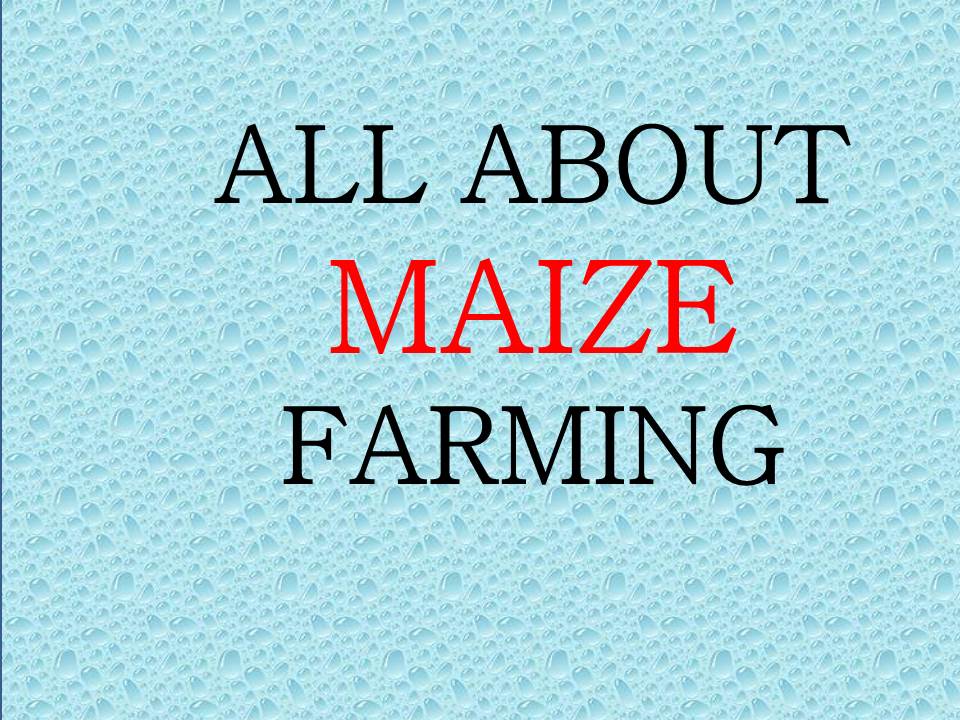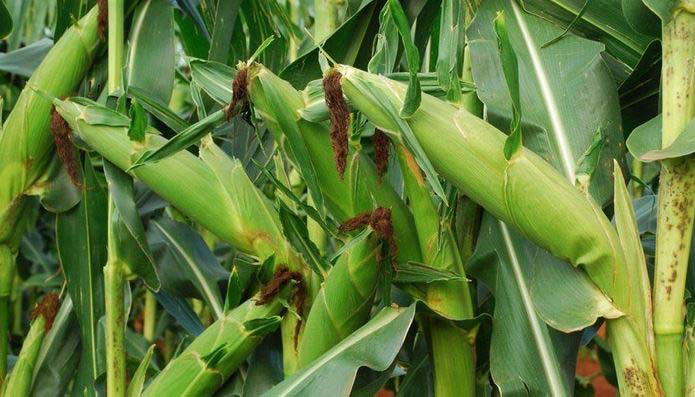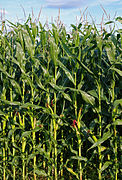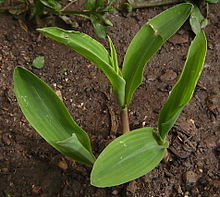Some introduction to Maize
Maize is interchangeably also known as corn. Natives of southern Mexico about 10,000 years ago are credited with first use of this cereal grain for consumption. Maize subsequently spread throughout the American continents. Maize spread to the rest of the world as European contacts happened with the Americas in the late 15th and early 16th century. Worldwide, production of maize surpasses that of wheat or rice.
Maize is a facultative long-night plant and flowers in a certain number of growing degree days > 50 °F (10 °C) in the environment to which it is adapted. The magnitude of the influence that long nights have on the number of days that must pass before maize flowers is genetically prescribed and regulated by the phytochrome system. Photoperiodicity can be eccentric in tropical cultivars, while the long day’s characteristic of higher latitudes allows the plants to grow so tall that they do not have enough time to produce seed before being killed by frost. These attributes, however, may prove useful in using tropical maize for biofuels.
The kernel of corn has a pericarp of the fruit fused with the seed coat, typical of the grasses. It is close to a multiple fruit in structure, except that the individual fruits (the kernels) never fuse into a single mass. The grains are about the size of peas, and adhere in regular rows round a white pithy substance, which forms the ear. An ear contains from 200 to 400 kernels, and is from 10–25 centimeters (4–10 inches) in length. They are of various colors: blackish, bluish-gray, red, white and yellow. When ground into flour, maize yields more flour, with much less bran, than wheat does. However, it lacks the protein gluten of wheat and therefore makes baked goods with poor rising capability.
- maize in field ready
- nascent maize plant
A genetic variation that accumulates more sugar and less starch in the ear is consumed as a vegetable and is called sweet corn.
Immature maize shoots accumulate a powerful antibiotic substance, DIMBOA (2,4-dihydroxy-7-methoxy-1,4-benzoxazin-3-one). DIMBOA is a member of a group of hydroxamic acids (also known as benzoxazinoids) that serve as a natural defense against a wide range of pests including insects, pathogenic fungi and bacteria. DIMBOA is also found in related grasses, particularly wheat. A maize mutant (bx) lacking DIMBOA is highly susceptible to be attacked by aphids and fungi. DIMBOA is also responsible for the relative resistance of immature maize to the European corn borer (family Crambidae). As maize matures, DIMBOA levels and resistance to the corn borer decline.
Classification of Maize
Maize (Zea mays) is an annual plant which belongs to family Gramineae and Genus Zea. A Zea may L. has 10 pair of chromosome. It is divided into eight groups on the basis of the endosperm of kernels.
Dent corn (Zea mays indentata Sturt)
Flint corn (Zea mays indurate Sturt)
Popcorn (Zea mays everta Sturt)
Flour corn (Zea mays amylacea Sturt)
Sweet corn (Zea mays saccharata Sturt)
Pod corn (Zea mays tunicate Sturt)
Waxy corn (Zea mays ceratina Kulesh)
Baby corn (Zea mays)
Nutrition provided by Maize
Raw, yellow, sweet maize kernels are mainly composed of
76% water,
19% carbohydrates,
3% protein, and
1% fat (table).
In a 100-gram serving, maize kernels provide 86 calories. Maize kernels are a good source (10-19% of the Daily Value) of the B vitamins, thiamin, niacin, pantothenic acid (B5) and folate. It also has dietary fiber and essential minerals, magnesium and phosphorus and low amounts of other nutrients.
Maize has a lower status as a protein source. The indigenous Americans overcame this deficiency with the inclusion of beans in their diet.
Use
Maize is a staple food for a large part of the population around the globe. However, Maize or Corn can be consumed in a variety of ways: including, but not limited to,
As porridge (such as grits, polenta, or ugali),
A popcorn, roasted or fired kernels,
As a vegetable (in the form of fresh, frozen, or canned sweet corn),
As flour or meal (cornbread, tortillas, chips, extruded snacks, etc.)
Ethanol (for either drinking or as a fuel source for motor vehicles),
As animal feed,
Biomass for energy,
Source of cooking oil,
Corn syrup and corn starch in the food industry.
Top Maize producers
As per data released for 2014, the following are the top ten countries in in decreasing order.
South Africa (15.5 million metric tons)
France (17.1 million metric tons)
Indonesia (19.0 million metric tons)
Mexico (32.6 million metric tons)
Ukraine (39.2 million metric tons)
Argentina (40.0 million metric tons)
India (42.3 million metric tons)
Brazil (83.0 million metric tons)
China (224.9 million metric tons)
USA (377.5 million metric tons)
Suitable Climate for Maize growing
Maize does well on a wide range of climatic conditions, and it is grown in the tropical as well as temperate regions, from sea-levels up to altitudes of 2500m. It is however susceptible to frost at all stages of its growth.
Maize is essentially a warm weather crop. It is grown under extremely divergent climatic conditions in different parts of the world, ranging from tropical to temperate regions. It is widely cultivated from the sea level up to altitudes of 2,500m. It can be successfully grown where the night temperature does not go below 15.6 degree C. It cannot withstand frost at any stage of it’s grow.
A large proportion of maize acreage is sown under rain fed conditions during the monsoon when over 80 per cent of the annual rainfall is received.
Land Preparation
Maize requires a firm and compact seed bed free from stubbles and weed. One deep Ploughing should be given, followed by two or three harrowing to bring the soil to a fine tilth. Add 10-15 tons of FYM or compost before last harrowing and mix thoroughly with harrow. Add some herbicides also get rid of weeds. For more details please refer to my page on this website “7-Steps for Successful Agricultural Practice by Farmers“.
Soil:
Maize can be grown successfully in variety of soils ranging from loamy sand to clay loam. Soils with good organic matter content having high water holding capacity with neutral pH are considered good for higher productivity. Avoid low lying fields having poor drainage and also the field having higher salinity as Maize is sensitive to both moisture stress and excess soil moisture.
Sowing Method
Maize seed should be sown with dibbling or drilling method. The chosen method depends on purpose of sowing, type of maize, varieties and farm condition.
Selection of seed:
Farmer needs to ensure to purchase seeds of good quality from reliable sources.
Seed treatment before sowing:
| Disease/insect-pest | Fungicide/Pesticide | Rate of application (gm./ kg seed) |
| Turcicum Leaf Blight, Banded Leaf, Sheath Blight, Leaf Blight | Bavistin + Captan in 1:1 ratio | 2.0 |
| BSMD | Apran 35 SD | 4.0 |
| Pythium Stalk Rot | Captan | 2.5 |
| Termite and shoot fly | Imidachlorprid | 4.0 |
Sowing time:
The optimum time of sowing are given below.
| Last week of June to first fortnight of July |
| Last week of October for inter cropping and up to15th of November for sole crop |
| First week of February |
Seed rate and plant geometry:
To achieve higher productivity and resource-use efficiencies optimum plant stand is the key factor. The seed rate varies depending on purpose, seed size, plant type, season, sowing methods etc. The following crop geometry and seed rate is suggested.
| Sr. No. | Purpose | Seed rate (kg ha-1) | Plant geometry (plant x row, cm) | Plant population |
| 1 | Grain (normal and  QPM) | 20 | 60 x 20 75 x 20 | 83333 66666 |
| 2 | Sweet corn | 8 | 75 x 25 75 x 30 | 53333 44444 |
| 3 | Baby corn | 25 | 60 x 20 60 x 15 | 83333 111111 |
| 4 | Pop corn | 12 | 60 x 20 | 83333 |
| 5 | Green cob (normal maize) | 20 | 75 x 20 60 x 20 | 66666 83333 |
| 6 | Fodder | 50 | 30 x 10 | 333333 |
| Farmers are well advised to contact agricultural officers of their area for the particular variety of seeds. |
Depth of sowing
Seed should not be sown more 5-6 cm depth of soil.
Weed management
Weeds are the serious problem in maize, particularly during rainy season crops they compete with maize for nutrient and causes yield loss up to 35 %. Therefore, timely weed management is needed for achieving higher yield.
Before planting of maize, use of available selective and non-selective herbicides like Atrazine, Gesaprim, Alochar, Metolachlor, Gluphosate, and Paraquat should be used. It goes without saying that adequate precaution and use of proper equipment needs to be taken.
Irrigation in Maize farming
The irrigation water management depends on season as about 80 % of maize is cultivated during monsoon season particularly under rain fed conditions. However, in areas with assured irrigation facilities are available, depending upon the rains and moisture holding capacity of the soil, irrigation should be applied as and when required by the crop and first irrigation should be applied very carefully wherein water should not overflow on the ridges/beds. In general, the irrigation should be applied in furrows up to 2/3rd height of the ridges/beds. Young seedlings, knee high stage, flowering and grain filling are the most sensitive stages for water stress and hence irrigation should ensure at these stages.
In raised bed planting system and limited irrigation water availability conditions, the irrigation water can also be applied in alternate furrow to save more irrigation water. In rain fed areas, tied-ridges are helpful in conserving the rainwater for its availability in the root zone for longer period. For winter maize, it is advisable to keep soil wet (frequent & mild irrigation) during 15 December to 15 February to protect the crop from frost injury.
It has been estimated that the maize crop requires about 50 per cent of the total water requirement in a short period of 30-35 days after tasselling. A lack of adequate moisture during the grain filling stage adversely affects yield.
Control of Pests and Diseases in Maize Farming
(A) Diseases:
Leaf Blight: Manifestation of oval to round, yellowish-purple spots on leaves. The affected leaves dry up and appear as if burnt. In severe cases, the plants may become stunted, resulting in poorly-formed ears.
Control:
The crop can be sprayed with Dithane M-45 or Indofil @ 35-40 Gms or Blue Copper @55 -60 Gms in 18 liters water, 2-3 sprays at 15 days interval, will effectively control the disease.
(B) Insect Pests:
Stem borer: These borers feed on leaves in the earlier stages. Later on they bore into the stem and cobs, rendering the plant unproductive.
Control:
– After harvest, the stalks and stubbles should be collected from the field and burnt.
– Crop can be sprayed twice with Thiodan 35 EC @ 27 ml in 18 liters water, once 20-25 days after germination and the Second spray at the time of grain formation (in endemic areas).
2) Red Hairy Caterpillars: Caterpillars feed and destroy the whole plant if the attack is in the early stages of growth.
Control:
– Egg masses and young caterpillars should be collected as soon as detected, and destroyed.
– The field should be ploughed out after the crop is harvested, so as to expose pupae.
– Thiodan 35 EC @ 27 ml in 18 liters water should be sprayed only as last resort.
3) Aphids: Tiny, soft bodied insects, usually green in color. Nymphs and adults suck the sap from leaves and young.
Risks of eating Maize
When maize was first introduced into farming systems other than those used by traditional native-American peoples, it was generally welcomed with enthusiasm for its productivity. However, a widespread problem of identified as PALLAGRA soon arose wherever maize was introduced as a staple food. It was eventually discovered that the indigenous Americans had learned to soak maize in alkali-water (the process now known as nixtamalization) —made with ashes and lime (calcium oxide) since at least 1200–1500 BC by Mesoamericans and North Americans—which liberates the B-vitamin niacin, the lack of which was the underlying cause of the condition known as pellagra. Newer varieties and method have evolved to introduce niacin to make maize food safer.
Pellagra still exists today in food-poor areas and refugee camps where people survive on donated maize.
Harvesting and Storage
The maize crop sown for grain is harvested when the grains are nearly dry and do not contain more than 20 per cent moisture. Ears are removed from the standing crop. Harvested ears are dried in the sun before shelling. In the case of the late-sown crop, farmers prefer to harvest the whole plants and pile them, and the ears are removed are removed later. Maize stalks are used as cattle feed or fuel.
In fact, no part of the maize plant, even the cobs from which the grains have been removed, is left unused.
While small holding farmers may use manual or low capacity mechanical shellers, large holding farmers use bigger shellers for grain removal from the cobs.
Yield
Considerable variation in grain yield is observed. The yield levels depend upon the variety, the amount of the fertilizer used, and the rainfall pattern etc. highest yield is said to be obtained in USA.
Suggestion for further Reading:
https://www.indiaagronet.com/indiaagronet/crop%20info/maize.htm




Leave a Reply